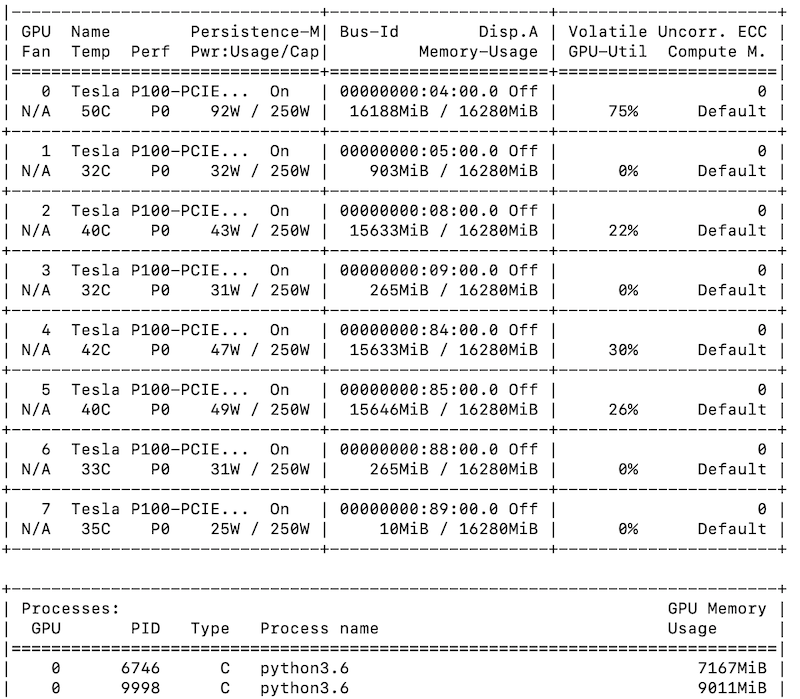
Wonderful tutorial from Github itself
Do this first! If you have an ssh key that’s in ssh-agent you are less likely to get a password prompt when ssh’ing into CSUA. It’s also necessary if you want to push to Github from CSUA.
id_rsa.pub file you created earlier. SSH to latte, create a `~/.ssh/authorized_keys’ file and copy the public key there.ssh to [yourusername]@latte.csua.berkeley.edu now. For convenience, you could add the following to your ~/.ssh/config file so that ssh csua just works.Host latte
HostName latte.csua.berkeley.edu
User YOUR_USER_NAME
IdentityFile PATH/TO/PRIVATE_KEYOther tips:
ssh -A will keep your credentials. So, for instance, if you have Github SSH acccess on your machine, -A will allow you to push to Github from your CSUA machine.
ssh -i path/to/key if you need to authenticate with a specific key.
There is another machine, [yourusername]@soda.csua.berkeley.edu which does not have GPUs. It’s kind of like an extra hive machine. Maybe extra CPU for your 170 project :)
Open two terminal windows, A and B.
In window A, ssh latte (or ssh username@latte.csua.berkeley.edu) and then install jupyter.
Run jupyter notebook --no-browser and check which port it’s using (in its terminal output).
There should be a line http://localhost:8888/?token=088de52ac910000087c9c24a15de8a0c68665ab1c2ee0687 or something like that.
Then in window B, run ssh -N -L [to]:localhost:[from] [username]@latte.csua.berkeley.edu
from is the port that Jupyter is running on CSUA (the number that you saw earlier). to is the port you want to connect Jupyter to on your machine. Ideally, you would set this to from as it makes everything easier. But if from is in use, you can find an open port by
Keep the ssh running. Now, in a browser, copy the line from above, but change the port number to to.
Example http://localhost:8888/?token=088de52ac910000087c9c24a15de8a0c68665ab1c2ee0687
so from is 8888.
but to is 8890.
then you would want to open the URL
http://localhost:8890/?token=088de52ac910000087c9c24a15de8a0c68665ab1c2ee0687
in a browser.
It should connect to Jupyter.
This happens sometimes.
localhost:[to]:localhost:[from] in the ssh -N -L command.nvidia-smi is a wonderful CUDA command. It will list the GPU usage.

You want to use GPUs with low Volatile GPU-Util and low Memory-Usage.
However, CSUA will by default assign you two random GPUs.
You can see which ones these are with echo $CUDA_VISIBLE_DEVICES.
If these are busy GPUs, or they are two of the same GPU (e.g. having a CUDA_VISIBLE_DEVICES of 0,0 will confuse Pytorch!) you may want to reassign them.
If you want to use more than two GPUs… well once I used 8 GPUs and my program was canceled along with a warning message. Be a good citizen :) many people want to ML on this cluster!
If you want to set your GPUs to, say, 6 and 7 run the command export CUDA_VISIBLE_DEVICES=6,7. It’s that simple! There are 8 GPUs available, numbered 0 through 7.
Create a virtualenv with python3 -m venv [name-of-env]. When you’re in the virtualenv your terminal will have a (name-of-env) before the prompt.
You can exit the environment with deactivate, and enter it with source [name-of-env]/bin/activate.
Install Pytorch with pip, then run this notebook to make sure GPU access is working. (You can download it to CSUA using wget or curl).